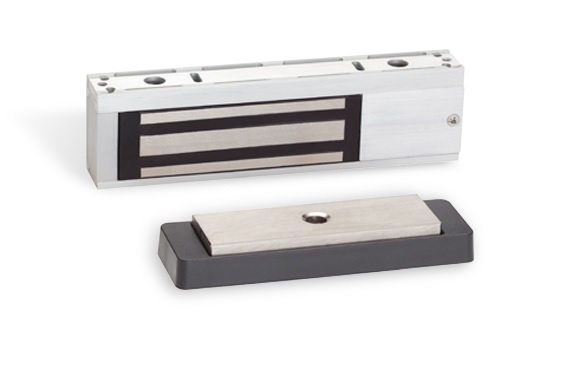
My class at DHI conNextions 2022
Update: I was teaching a new class on electrified hardware code requirements last week, and some questions came up about a change that will be made in the 2024 IBC. I am updating this post to include the information on the change, as it is a pretty significant one.
I mentioned it in this article on 2024 code changes, but in case you missed it, electrified locks released by a sensor (typically mag-locks) will no longer be allowed by the IBC on doors serving assembly and educational occupancies where panic hardware is required.
There is more info about the change at the bottom of this post.
~~~
In a perfect world, you could pick up any edition of any code or standard and understand the intent. Unfortunately, we don’t live in a perfect world, and sometimes it takes a bit of historical background to know for sure what the codes are trying to say. This is true of today’s Quick Question:
According to the IBC, can a door with panic hardware or fire exit hardware also have an electromagnetic lock?
 This has been clarified over several editions of the International Building Code (IBC), but it took a while to get it right (and there’s another change coming in 2024 – see below). So if you are reading one edition of the code without knowing what changes occurred before or after, it could be confusing and difficult to interpret.
This has been clarified over several editions of the International Building Code (IBC), but it took a while to get it right (and there’s another change coming in 2024 – see below). So if you are reading one edition of the code without knowing what changes occurred before or after, it could be confusing and difficult to interpret.
There is a section of the IBC that addresses panic hardware, and there are two sections that address electromagnetic locks. One of these sections is for mag-locks released by a sensor above the door to allow egress. The other is for mag-locks released by a switch in the door-mounted hardware. The section numbers and even the titles of these sections have changed in recent editions of the IBC, so I will call these two systems either “sensor release” or “door-hardware release”. (Here’s a video if you need more info on the two types of systems.)
In the 2009 edition of the IBC, as well as prior editions, the section on panic and fire exit hardware states that certain doors can only have a latch or lock if it is panic hardware or fire exit hardware. This would effectively prohibit the use of any other type of lock to be used on a door with panic hardware. Some code officials interpreted this to mean that an electromagnetic lock could not be installed on a door with panic hardware, although it was not a common interpretation and that was not the intent of the code. Here’s the panic hardware section:
IBC-2009: 1008.1.10 Panic and fire exit hardware. Doors serving a Group H occupancy and doors serving rooms or spaces with an occupant load of 50 or more in a Group A or E occupancy shall not be provided with a latch or lock unless it is panic hardware or fire exit hardware.
In the 2012 edition, a requirement was added to the door-hardware release section, clarifying that if the mag-lock was installed on a door with panic hardware, operation of the panic had to release the mag-lock (by activating a switch). This meant that the mag-lock and panic hardware could be installed on the same door, but the problems were: a) the panic hardware section still said the only type of lock or latch allowed on certain doors was panic hardware, and b) the sensor release section did not have a similar reference to doors with panic hardware.
IBC-2012: 1008.1.9.9 Electromagnetically locked egress doors. (5) Where panic or fire exit hardware is required by Section 1008.1.10, operation of the listed panic or fire exit hardware also releases the electromagnetic lock.
In the 2015 edition, an exception was added to the panic hardware section, allowing doors with panic hardware to have mag-locks with door-hardware release, but there was no reference to mag-locks with sensor release. There was never a prohibition on installing mag-locks with sensor release on doors with panic hardware, but the reference to one type of mag-locks and not the other could be interpreted to mean that mag-locks with sensor release were not allowed on doors with panic hardware. The person who recently asked me this question was looking at the 2015 edition and interpreted it in exactly this way.
IBC-2015: 1010.1.10 Panic and fire exit hardware. (2) Doors serving a Group A or E occupancy shall be permitted to be electromagnetically locked in accordance with Section 1010.1.9.9.
It was finally cleared up in the 2018 edition of the IBC, and the same language has been carried forward into the 2021 edition. In the panic hardware section there is now an exception that allows mag-locks with door-hardware release or mag-locks with sensor release to be installed on doors with panic hardware. Spoiler Alert: The 2024 IBC will remove the sensor release reference.
IBC-2018 & 2021: 1010.1.10 Panic and fire exit hardware. (2) Doors provided with panic hardware or fire exit hardware and serving a Group A or E occupancy shall be permitted to be electrically locked in accordance with Section 1010.1.9.9 or 1010.1.9.10.
Keep in mind that this is not a change, per se. Past editions of the IBC did not prohibit mag-locks with sensor release on doors with panic hardware and only allow mag-locks with door-hardware release. Doors with panic hardware can have electromagnetic locks as long as all of the criteria in the adopted codes are met. Also note that there is no exception in the IBC that would allow doors requiring panic hardware to have electromagnetic locks instead. Panic hardware is still required by the IBC for doors equipped with a lock or latch, serving assembly and educational occupancies with a calculated occupant load of 50 people or more (and high hazard occupancies of any occupant load). The electromagnetic lock could be used in addition to the panic hardware, but not in place of it.
Change coming in 2024:
IBC-2024: 1010.2.8 Panic and fire exit hardware. (2) Doors provided with panic hardware or fire exit hardware and serving a Group A or E occupancy shall be permitted to be electrically locked in accordance with Section 1010.2.10. (the reference to the section for sensor release locks has been removed)
ICC Proposal E48-21 has been approved as submitted, so in the 2024 edition of the IBC, the panic hardware section will allow doors to have panic hardware + an electrified lock released by a switch in the panic hardware. It will not allow doors that are required to have panic hardware to have panic hardware + an electrified lock released by a sensor.
Note that this limitation does not apply to every door that has panic hardware and a mag-lock. For example, in a health care facility, a cross-corridor door could have panic hardware + an electromagnetic lock released by a sensor, as long as the door is not serving as a means of egress for an assembly (or educational) occupancy – like the hospital cafeteria. If the door is serving an area that is an institutional occupancy, the IBC would allow the panic hardware along with a sensor release lock.
This is my interpretation, and my reasoning is based on the fact that the panic hardware section of the code applies to swinging doors serving a Group H occupancy and swinging doors serving rooms or spaces with an occupant load of 50 or more in a Group A or E occupancy. This section, where the change will be made, does not apply to doors in other occupancy types or to doors in assembly or educational occupancies serving areas with a calculated occupant load of less than 50. The section of the code that addresses sensor release locks does not limit their use in certain occupancy types, with the exception of high hazard.
Any questions?
You need to login or register to bookmark/favorite this content.






All that being said is the requirement for an alternate release button/switch still required when a sensor is used or with a RX switch in the exit device?
Hi Bryan –
The button is required by the model codes for a sensor release system but not for a door hardware release system.
– Lori
This issue of maglocks on doors equipped with panic hardware, was primarily an issue for security companies who were contracted by the building owner separately! This was a common and prevalent problem. After a building’s construction was completed, the owner would call in a security company to install card access at critical existing door openings that have panic hardware. The easiest thing for the security company to do was to add a maglock with a separate or built-in motion sensor, and a second (redundant) push-button release. Sometimes, they might even add a power supply unit. A lot of this work was simply done “under the radar” and hardly ever inspected afterwards for compliance by the LAHJ. Then came the low profile electric strikes that simplified things even further and eliminated the egress code issue. These strikes required little modification of the frame and could be powered by the card reader system.
My problem with these code compliance issues is this: There remains to this day, a severe lack of coordination between the owner and the architect in having the security/card access system, the fire alarm system and our very sophisticated electro-mechanical door hardware, closely coordinated and integrated into the building’s original construction documents. Unfortunately, this usually ends up as an afterthought and a “cluster”, if you know what I mean.
Makes good sense. As long as the occupant has control of his/her egress it is approved.
Two questions – Maglock with panic hardware – does this door need to be connected to the fire alarm system also. And if the security systems is on emergency power, there will never be a loss of power – are maglocks to be powered from non-emergency power?
If panic hardware is not used, but the release switch is in the door handle, do you still need a motion detector and push button at the door?
Hi Rene –
Regardless of whether the door has panic hardware, the fire alarm contact is required for mag-locks released by a sensor – like a motion sensor above the door. The model codes do not require the fire alarm contact if the mag-lock is released by a switch in the door-mounted hardware.
Both types of mag-lock systems (sensor release and door hardware release) must unlock to allow egress upon loss of power. The codes don’t include much prescriptive information on this, but my interpretation is that if it’s a sensor release system, the fire alarm should be on the same backup power as the lock. I wrote more about this here: https://idighardware.com/2020/06/qq-battery-back-up/.
– Lori
Hi Lori,
For an A-occupancy that requires panic hardware due to the number of occupants, the sensor release of magnetic locks (along with redundant pushbutton switch and fire alarm release) still requires panic hardware to be installed on the doors, right?
It seems that–if so–the panic hardware would need to typically be dogged to allow the doors to be pulled open from the exterior when the magnetic locks are released by a card reader. I have one client thinking that the code doesn’t require panic hardware to be installed at doors under 1010.1.9.9 that would otherwise require panic hardware. What is your opinion? Thanks!
Hi Jon –
Yes – the common interpretation is that the door would still require panic hardware, and yes, the panic hardware would need to be dogged or otherwise able to be released from the exterior in order to use the mag-lock for access control.
– Lori
Thank you, Lori!
Door locks have evolved from the basic deadbolt lock to the incredibly sophisticated magnetic door locks for homes. You have a choice between the fail-safe lock and the fail-secure lock, two different sorts of locks. In the event of a power outage, a fail-safe lock immediately unlocks, preventing individuals from becoming imprisoned. On the other hand, a fail-secure lock will stay locked even if there is no power.
Hi John –
In most cases, the fail safe / fail secure function of the electrified lock is referring to the outside or access side of the door, not the egress side. Fail secure locks that allow free egress do not imprison anyone, as they can use the hardware to exit at any time – regardless of the status of the access control system. This article may be helpful to you: https://idighardware.com/2022/10/faqs-about-fail-safe-and-fail-secure/.
– Lori